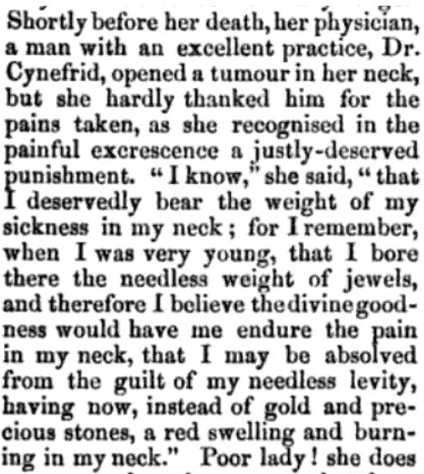JMS Pearce
Hull, England, UK
Medicine is full of strange tales, some with unforeseen ramifications. I recently discovered that the origins of the useful word “tawdry” surprisingly lay in a tumor of the throat—nature unspecified—of a seventh-century saint.
St. Audrey, Etheldrida, or Æþelðryþ, born c. 636 AD, was an English princess generally referred to as Audrey, (Fig 1) the daughter of Anna, King of the East Angles. Because she had taken a perpetual vow of virginity, she had two unconsummated marriages. She took the veil, and in 672 founded the great Abbey of the Isle of Ely, where she lived an austere life as its patron saint. In her youth, as a display of vanity, she had adorned her neck with many ornate and spectacular necklaces. When she eventually developed a large painful swelling of her throat, she believed it was caused by Divine retribution for her vanity in wearing the necklaces in her early years:1
 |
The venerable Bede portrayed her life.2 The nature of the swelling, abscess, or tumor, is unknown. Bede’s history reads: “She had a very great swelling under her jaw [apparently thought to be a plague bubo]. ‘And I was ordered,’ said he [i.e. Cynefrid], ‘to lay open that swelling, to let out the noxious matter in it, which I did, and she seemed to be somewhat more easy for two days, so that many thought she might recover from her distemper; but the third day the former pains returning, she was soon snatched out of the world, and exchanged all pain and death for everlasting life and health.’” Cynefrid’s account of noxious matter suggests an abscess. Etheldreda’s description of pain, swelling, and redness also suggests an inflammatory lesion, possibly an abscess or thyroiditis, but a thyroid or other neck cancer cannot be excluded. She died in 679.
 |
| Fig 1. St. Etheldreda [Audrey]. Source. |
In the sixteenth and early seventeenth centuries, in her memory, St. Audrey’s lace was named after her for silk lace or neckties, worn by women; the term was sometimes more widely used for any showy female adornments. (tawdry lace: Oxford English Dictionary)
Throughout the Middle Ages, a festival, St. Audrey’s Fair, was held on June 23rd at Ely on her feast day. St. Audrey’s laces were offered for sale at her fair, which doubtless made it more widely known. And, it led to the production of cheap and showy finery for the country wenches, which eventually gave “tawdry” its later connotation of cheap, shoddy, or pretentious. This contributed to the English language word “tawdry,” a corruption of “Saint Audrey.
Shakespeare refers to it in the Winter’s Tale iv. 248:
Come you promis’d me a tawdry-lace, and a paire of sweet Gloues.
References
- Mrs Matthew Hall. The Queens before the conquest. Gentleman’s Magazine, 1854. p.537
- The venerable Bede. Ecclesiastical History Of The English People. IV.19. ed. B.Colgrave & R.A.B. Mynors. Oxford. 1969.
JMS PEARCE is a retired neurologist and author with a particular interest in the history of science and medicine.
Spring 2021 | Sections | History Essays

Leave a Reply